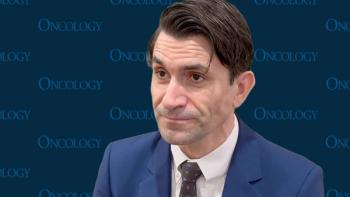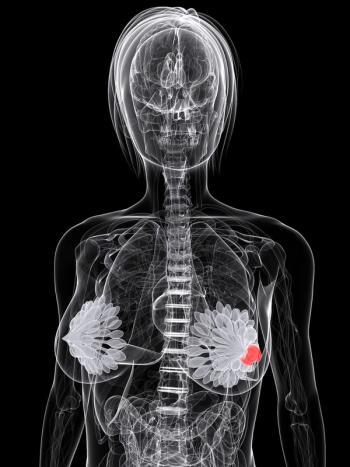
Pembrolizumab Plus Lenvatinib May Serve as Potential Frontline Treatment for Non–Clear Cell RCC
Patients with locally advanced/metastatic non–clear cell renal cell carcinoma experienced promising preliminary antitumor activity following treatment with pembrolizumab and lenvatinib in the first line.
Lenvatinib (Lenvima) and pembrolizumab (Keytruda) in the frontline demonstrated promising responses at 24 weeks or more of follow-up in patients with locally advanced/metastatic non–clear cell renal cell carcinoma (RCC), according to preliminary findings from the single-arm, open-label phase 2 KEYNOTE-B61 trial (NCT04704219).
The overall response rate (ORR) in patients treated with the combination (n = 82) was 47.6% (95% CI, 36.4%-58.9%) and the disease control rate (DCR) was 79.3% (95% CI, 68.9%-87.4%). When responses were assessed by disease histology, investigators reported an ORR by blinded independent central review (BICR) of 52.9% (n = 27/51; 95% CI, 38.5%-67.1%) for papillary RCC, 13.3% (n = 2/15; 95% CI, 1.7%-40.5%) for chromophobe RCC, 60.0% (n = 3/5; 95% CI, 14.7%-94.7%) for translocation RCC, 71.4% (n = 5/7; 95% CI, 29.0%-96.3%) for unclassified RCC, and 50.0% (n = 2/4; 95% CI, 6.8%-93.2%) for other types of RCC.
Patients were eligible to participate in the study if they had a histologically confirmed diagnosis of non–clear cell RCC, locally advanced or metastatic disease, and did not undergo previous treatment with a systematic therapy. Other inclusion criteria included measurable disease based on RECIST v1.1 criteria, available tumor tissue sample, and a Karnofsky performance status of at least 70%.
The treatment regimen consisted of an intravenous 400 mg dose of pembrolizumab every 6 weeks for 18 or less cycles for approximately 2 years and 20 mg of oral lenvatinib every day. Initial tumor occurred 12 weeks from the allocation of treatment, with subsequent assessments taking place once every 6 weeks and once every 12 weeks thereafter.
The primary end point of the trial was ORR by BICR, with secondary end points including DCR, duration of response (DOR), progression-free survival (PFS), overall survival (OS), clinical benefit rate (CBR), and safety. At the time of the analysis, median PFS, DOR, and OS had yet to be reached.
A total of 147 patients received treatment with pembrolizumab and lenvatinib and treatment was ongoing in 123 patients. A total of 24 patients discontinued treatment; reasons for discontinuation included progressive disease (n = 13), adverse effects (AEs; n = 6), clinical progression (n = 2), patient decision (n = 2), and physician decision (n = 1). Eighty-two patients were included in the efficacy population.
Within the efficacy population, the median patient age was 64 years (range of 24-87). A total of 67.1% of patients had a combined positive score (CPS) of 1 or more and 26.8% had a CPS of less than 1. In terms of histology, 62.2% of diseases were papillary, 18.3% were chromophobe, 8.5% were unclassified, 6.1% were translocation, and 4.9% were another disease type.
The best percentage change in tumor burden from baseline by BICR was 86.5% for the overall population; 86.3% for the papillary cohort; 80.0% in the chromophobe cohort; and 93.4% for the unclassified, translocation, and other cohort. At a median follow-up of 8.2 months, the median time to response was 2.8 months. Moreover, the median DOR was not reached (NR). At the data cut-off, all patients who achieved a complete response were continuing treatment.
At a median follow-up of 8.2 months, the PFS rate by BICR was 72.3% (95% CI, 60.7%-81.0%) and the median PFS was NR (95% CI, 8.4-NR). The OS rate at the same follow-up was 87.8% (95% CI, 78.5%-93.2%) and the median OS was not reached (95% CI, NR-NR).
Any grade treatment-related adverse effects (TRAEs) were observed in 86.4% of patients who received at least 1 dose of treatment; no grade 5 TRAEs occurred. The most common any grades TRAEs included hypertension (48.3%), diarrhea (25.2%), hypothyroidism (25.2%), dysphoria (24.5%), fatigue (22.4%), and palmar-planter erythrodysesthesia (21.1%). The most frequent grade 3/4 TRAEs were hypertension, proteinuria, stomatitis, asthenia, and palmar-planter erythrodysesthesia.
These data were presented at the
Reference
Albiges L, Gurney H, Atduev V, et al. Phase II KEYNOTE-B61 study of pembrolizumab (pembro) + lenvatinib (lenva) as first-line treatment for non-clear cell renal cell carcinoma (nccRCC). Ann Oncol. 2022;33(suppl 7):S660-S680. doi:10.1016/annonc/annonc1072
Newsletter
Stay up to date on recent advances in the multidisciplinary approach to cancer.

















































































